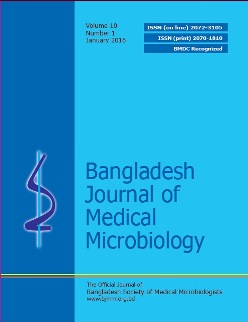Detection Of Mutated gyrA Gene From Nalidixic Acid Resistant Salmonella Typhi And Paratyphi A Isolated From Enteric Fever Patients In A Tertiary Care Hospital Of Bangladesh
DOI:
https://doi.org/10.3329/bjmm.v10i1.31431Keywords:
Bangladesh, gyrA gene mutation, nalidixic acid resistance, Salmonella typhi, Salmonella paratyphi A.Abstract
A cross sectional study for the detection of empirically used antibiotic resistant Salmonella was carried out in the department of microbiology of Rajshahi Medical College (RMC) and PCR and DNA sequencing were done in the department of microbiology of Dhaka Medical College during the period from August 2014 to July 2015.Total 323 blood samples were collected from suspected enteric fever patients from medicine and paediatric units of RMC hospital and cultured on brain heart infusion broth for isolation of Salmonella. Identification of Salmonella was done by biochemical tests and final identification was done by specific antisera. Antimicrobial sensitivity test was done by disc diffusion technique. PCR was used to detect gyrA gene. Sequencing of the gyrA gene was done to see mutation. Culture yielded growth of Salmonella typhi in 11 (36.67%) and Salmonella paratyphi A in 19(63.33%) samples. Among 11 Salmonella typhi, 8(72.73%) were resistant to nalidixic acid, 2(18.18%) to ciprofloxacin and one (9.09%) to ofloxacin. Among 19 Salmonella paratyphi A, all (100%) were resistant to nalidixic acid, 4(21.05%) to ofloxacin, and 3 (15.79%) to ciprofloxacin. All the Salmonella typhi and Salmonella paratyphi A were gyrA gene positive. All the nalidixic acid resistant strains of Salmonella typhi and Salmonella paratyphi A were mutated at amino acid position 83 by replacing serine with phenylalanine. None of the nalidixic acid sensitive Salmonella strain had mutated gyrA gene.
Bangladesh J Med Microbiol 2016; 10 (1): 3-7
Downloads
154
158

